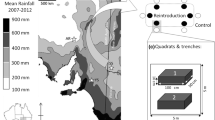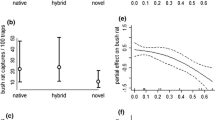Abstract
Habitat modifying species can play crucial roles in ecosystem function. Invasive engineers may assume these roles where native engineers have been lost from the system. We compared the dynamics of the foraging pits of an invasive engineer, the European rabbit (Oryctolagus cuniculus) with two native mammals, the greater bilby (Macrotis lagotis) and the burrowing bettong (Bettongia lesueur). Foraging pits are small surface depressions created by animals when they forage for seeds, bulbs, roots, invertebrates and fungi. We measured foraging pit density and turnover, and density and richness of plant seedlings in pits and adjacent surfaces across three landforms representing a gradient in resource availability inside (bilbies and bettongs), and outside (rabbits only) a reserve in an arid Australian shrubland over 2 years. Pits of the native engineers contained 80% more seedlings (11.2 plants m−2) than rabbit pits (6.22 plants m−2). Further, rabbit pits supported 3.6-times fewer seedlings than equivalent non-pit surfaces outside the exclosure. Only one plant species was restricted entirely to pits. The reserve had more foraging pits and greater turnover than outside, but contrary to prediction, pit effects on seedling density were no greater in the more resource-limited dunes. There were some strong temporal and landscape effects on pit density and species composition, but generally trends were similar inside and outside the reserve. Overall, despite their functional similarities, invasive rabbits created fewer pits that were less favourable patches for seedlings than those of native engineers. Our work suggests that a suite of ecosystem processes associated with fertile patch creation has potentially been lost with the extirpation of bilbies and bettongs.





Similar content being viewed by others
References
Alkon PU (1999) Microhabitat to landscape impacts: crested porcupine digs in the Negev Desert highlands. J Arid Environ 41:183–202
Anderson MJ, Gorley RN (2008) PERMANOVA + for PRIMER: guide to software and statistical methods. PRIMER-E, Plymouth
Anderson CB, Griffith CR, Rosemond AD, Rozzi R, Dollenz O (2006) The effects of invasive North American beavers on riparian plant communities in Cape Horn, Chile: do exotic beavers engineer differently in sub-Antarctic ecosystems? Biol Conserv 128:467–474
Boeken B, Shachak M, Gutterman Y, Brand S (1995) Patchiness and disturbance: plant community responses to porcupine diggings in the central Negev. Ecography 18:410–421
Bragg CJ, Donaldson JD, Ryan PG (2005) Density of Cape porcupines in a semi–arid environment and their impact on soil turnover and related ecosystem processes. J Arid Environ 61:261–275
Brusati ED, Grosholz ED (2006) Native and introduced ecosystem engineers produce contrasting effects on estuarine infaunal communities. Biol Conserv 8:683–695
Courchamp F, Chapuis JL, Pascal M (2003) Mammal invaders on islands: impact control and control impact. Biol Rev 78:347–383
Crooks JA (2002) Characterizing ecosystem-level consequences of biological invasions: the role of ecosystem engineers. Oikos 97:153–166
Dufréne M, Legendre P (1997) Species assemblages and indicator species: the need for a flexible asymmetrical approach. Ecol Monog 67:345–366
Duval BD, Jackson E, Whitford WG (2005) Mesquite (Prosopis glandulosa) germination and survival in black–grama (Bouteloua eriopoda) grassland: relations between microsite and heteromyid rodent (Dipodomys spp.) impact. J Arid Environ 62:541–554
Edwards J (2001) Monitoring vegetation change under different arid management regimes, near Olympic Dam, South Australia, using Landsat TM imagery. BSc Thesis, University of Adelaide, South Australia
Eldridge DJ, Mensinga A (2007) Foraging pits of the short-beaked echidna (Tachyglossus aculeatus) as small-scale patches in a semi-arid Australian box woodland. Soil Biol Biochem 39:1055–1065
Eldridge DJ, Whitford WG (2009) Badger (Taxidea taxus) disturbances increase soil heterogeneity in a degraded shrub-steppe ecosystem. J Arid Environ 73:66–73
Finlayson GR, Moseby KE (2004) Managing confined populations: the influence of density on the home range and habitat use of reintroduced burrowing bettongs (Bettongia lesueur). Wildl Res 31:457–463
Gutterman Y (1997) Spring and summer daily subsurface temperatures in three microhabitats in a flat natural loess area in the Negev Desert Israel. J Arid Environ 63:225–235
Gutterman Y, Golan T, Garsani M (1990) Porcupine diggings as a unique ecological system in a desert environment. Oecologia 85:122–127
Hacker SD, Gaines SD (1997) Some implications of direct positive interactions for community species diversity. Ecology 78:1990–2003
Huntly N, Reichman OJ (1994) Effects of subterranean mammalian herbivores on vegetation. J Mammal 75:852–859
Inouye RS, Huntly NJ, Tilman D, Tester JR (1987) Pocket gophers (Geomys bursarius), vegetation, and soil nitrogen along a successional sere in east central Minnesota. Oceologia 73:178–184
James AI, Eldridge DJ (2007) Reintroduction of fossorial native mammals and potential impacts on ecosystem processes in an Australian desert landscape. Biol Conserv 138:351–359
James AI, Eldridge DJ, Hill BM (2009) Foraging animals create fertile patches on an Australian desert shrubland. Ecography 32:723–732
Johnson C (2006) Australia’s mammal extinctions: a 50000 year history. Cambridge University Press, Melbourne
Jones CG, Lawton JH, Shachak M (1997) Positive and negative effects of organisms as physical ecosystem engineers. Ecology 78:1946–1957
Lafferty KD, Gerber LR (2002) Good medicine for conservation biology: the intersection of epidemiology and conservation theory. Conserv Biol 16:593–604
Le Houerou HN (1984) Rain use efficiency: a unifying concept in arid-land ecology. J Arid Environ 7:213–247
Levine JM, McEachern AK, Cowan C (2008) Rainfall effects on rare annual plants. J Ecol 96:795–806
McCune B, Mefford MJ (1999) PC-ORD: multivariate analysis of ecological data. Version 4. User’s guide. MjM Software Design, Gleneden Beach
Moseby KE, O’Donnell E (2003) Reintroduction of the greater bilby, Macrotis lagotis (Reid) (Marsupalia: Thylacomyidae), to northern South Australia: survival, ecology and notes on reintroduction protocols. Wildl Res 30:15–27
Myers K, Parer I, Wood D, Cooke BD (1994) The rabbit in Australia. In: Thompson V, King CM (eds) The European rabbit: the history and biology of a successful colonizer, vol 5. Oxford University Press, New York, pp 108–157
Naiman RJ, Johnston CA, Kelley JC (1988) Alteration of North American streams by beaver. Bioscience 38:753–762
Newell J (2008) The role of the reintroduction of Greater Bilbies (Macrotis lagotis) and Burrowing Bettongs (Bettongia lesueur) in the ecological restoration of an arid ecosystem: foraging diggings, diet, and soil seed banks. PhD Thesis, University of Adelaide, South Australia
Noble JC, Hik DS, Sinclair ARE (1995) Landscape ecology of the burrowing bettong: fire and marsupial biocontrol of shrubs in semi-arid Australia. Rangel J 29:107–119
Noy-Meir I (1979) Structure and function of desert ecosystems. Israel J Bot 28:1–19
Olympic Dam Operations (1994) Environmental management program annual report 1994. Olympic Dam Operations, Olympic Dam
Payne RW, Harding SA, Murray DA, Soutar DM, Baird DB, Glaser AI, Channing IC, Welham SJ, Gilmour AR, Thompson R, Webster R (2008) The guide to GenStat release 11, Part 2: statistics. VSN International, Hemel Hempstead
Predavec M (2000) Food limitation in Australian desert rodents: experiments using supplementary feeding. Oikos 91:512–522
Recovery Arid (2007) Arid recovery annual report, 2006. Arid Recovery, Roxby Downs
Robley AJ, Short J, Bradley S (2001) Dietary overlap between the burrowing bettong and the European rabbit in semi–arid coastal Western Australia. Wildl Res 28:341–349
Shachak M, Brand S, Gutterman Y (1991) Porcupine disturbances and vegetation pattern along a resource gradient in a desert. Oecologia 88:141–147
Short J, Smith A (1994) Mammal decline and recovery in Australia. J Mammal 75:288–297
Slobodchikoff CF, Doyen JT (1977) Effects of Ammophila arenaria on sand dune arthropod communities. Ecology 58:1171–1175
Southgate R (1990a) Habitat and diet of the Greater Bilby Macrotis lagotis Reid (Marsupalia: Peramelidae). In: Seebeck JH, Brown PR, Wallis RI, Kemper CM (eds) Bandicoots and Bilbies. Surrey Beatty, Sydney, pp 303–309
Southgate R (1990b) Distribution and abundance of the greater bilby Macrotis lagotis Reid (Marsupialia: Peramelidae). In: Seebeck JH, Brown PR, Wallis RI, Kemper CM (eds) Bandicoots and Bilbies. Surrey Beatty, Sydney, pp 293–302
Strahan RS (1995) The mammals of Australia, 2nd edn. Reed New Holland, Sydney
Travers S (2008) Foraging pit soil enhances the growth and production of an annual native grass. BSc (Hons.) Thesis, University of New South Wales, Sydney
Vander Wall SB (1998) Foraging success of granivorous rodents: effects of variation in seed and soil water on olfaction. Ecology 79:233–241
Vitousek PM (1990) Biological invasions and ecosystem processes: towards an integration of population biology and ecosystem studies. Oikos 57:7–13
Whitford WG (2002) Ecology of desert systems. Elsevier, London
Wright JP, Jones CG (2004) Predicting effects of ecosystem engineers on patch-scale species richness from primary productivity. Ecology 85:2071–2081
Wright JP, Gurney WSC, Jones CG (2004) Patch dynamics in an engineered landscape. Oikos 105:336–348
Yair A, Rutin J (1981) Some aspects of the regional variation in the amount of available sediment produced by isopods and Porcupines, northern Negev, Israel. Earth Surf Process Landf 6:221–234
Zaady E, Gutterman Y, Boeken B (1997) The germination of mucilaginous seeds of Plantago coronopus, Reboudia pinnata, and Carrichtera annua on cyanobacterial soil crust from the Negev Desert. Plant Soil 190:247–252
Zavaleta ES, Hobbs RJ, Mooney HA (2001) Viewing invasive species removal in a whole ecosystem context. Trends Ecol Evol 16:454–459
Acknowledgments
We thank Adam Bester and staff and volunteers of Arid Recovery for support in the field, Steve Shoobert for calculations of pit turnover, and Frank Hemmings for assistance with plant identification. This study was supported by Arid Recovery, a joint conservation initiative between BHP Billiton, University of Adelaide, S.A. Department for Environment and Heritage and the Friends of Arid Recovery. The research was carried out under appropriate University of NSW ethics guidelines.
Author information
Authors and Affiliations
Corresponding author
Electronic supplementary material
Below is the link to the electronic supplementary material.
Rights and permissions
About this article
Cite this article
James, A.I., Eldridge, D.J., Koen, T.B. et al. Can the invasive European rabbit (Oryctolagus cuniculus) assume the soil engineering role of locally-extinct natives?. Biol Invasions 13, 3027–3038 (2011). https://doi.org/10.1007/s10530-011-9987-9
Received:
Accepted:
Published:
Issue Date:
DOI: https://doi.org/10.1007/s10530-011-9987-9




